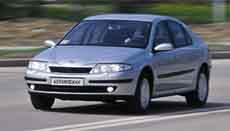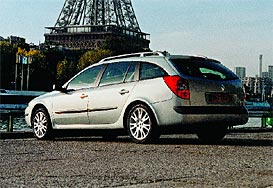Test drive by Renault Laguna 2001 - 2005 hatchback
Time is medium European
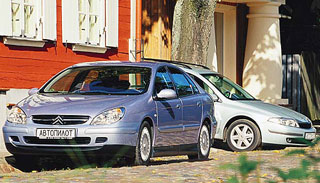 Time dictates its laws. Most firms obey its course and change the image, for example, offering Citroen C5 and Renault Laguna II Break.
Time dictates its laws. Most firms obey its course and change the image, for example, offering Citroen C5 and Renault Laguna II Break. We foresee the indignation of readers - how can you compare two completely different cars?! But we went consciously for this. They agree, they are different. Even too much. But there is what unites Citroen C5 and Renault Laguna II. Both cars showed a new approach of both companies to their market offers. We are sure: people will buy these models, different in their social position and status. However, each client, in addition to the standard and options, will receive the hidden proposal of the automaker in addition: evaluate the quality of the French automotive industry at the beginning of the 21st century.
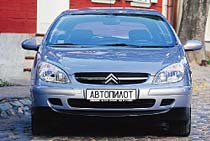 Plus two. Citroen C5, according to the European classification, belongs to the class D is a middle business class. In Europe, wealthy managers who are tired of unified European studies are already buying it out in full swing. These people use a car with benefit for a growing family and the benefit for the image. And the image in the case of Citroen is primary-unusual rounded-flared shapes and cabin, as if shifted forward, sharply release this car from the total mass in the stream and in the parking lot. A sort of camouflage effect, when designers and designers are trying to present a hatchback sedan.
Plus two. Citroen C5, according to the European classification, belongs to the class D is a middle business class. In Europe, wealthy managers who are tired of unified European studies are already buying it out in full swing. These people use a car with benefit for a growing family and the benefit for the image. And the image in the case of Citroen is primary-unusual rounded-flared shapes and cabin, as if shifted forward, sharply release this car from the total mass in the stream and in the parking lot. A sort of camouflage effect, when designers and designers are trying to present a hatchback sedan. Renault Laguna II Break is more conservative for its purpose, but no less progressive in its design. At the same time - a rare thing - the station wagon looks much more elegant than the hatchback. It is assumed that they buy such a car primarily to solve their home problems - a large family, a passion for distant travel. Prestige and grace are fading into the background.
In our country, where everything is spoiled by the poor climate and difficult childhood of existing characters, the attitude to the car is slightly different from the average European one as a temporary belt. You always need to make an amendment for two hours.
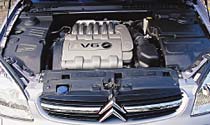 PLUS ONE. Citroen C5, without a doubt, will use us as a representative car. The prerequisites for this are more than enough. Firstly, the body was designed much higher and wide than the classic in the classic Class D is allowed. The salon is spacious and a lot of air. But this scope is intended exclusively for passenger comfort. In it you can relax on the back sofa, impressively spread your hands, describing the advantages of a new deal, or just read the Kommersant newspaper. At the same time, thin skin creaks deliberately, and the driver’s hands squeeze a perfectly thought -out working surface of the steering wheel, the checkpoint handle, press numerous handles and buttons to control the life support systems.
PLUS ONE. Citroen C5, without a doubt, will use us as a representative car. The prerequisites for this are more than enough. Firstly, the body was designed much higher and wide than the classic in the classic Class D is allowed. The salon is spacious and a lot of air. But this scope is intended exclusively for passenger comfort. In it you can relax on the back sofa, impressively spread your hands, describing the advantages of a new deal, or just read the Kommersant newspaper. At the same time, thin skin creaks deliberately, and the driver’s hands squeeze a perfectly thought -out working surface of the steering wheel, the checkpoint handle, press numerous handles and buttons to control the life support systems. Of the several C5 modifications, we chose the most naughty. The engine is a new three-liter V-shaped six with a capacity of 210 hp, the salon is leather, and the electronics is like at the Expo 2001 exhibition: climate control with an ultraviolet sensor, rain sensors and automatically inclusion of near light. Naturally, the car is equipped with an automatic 4-speed gearbox.
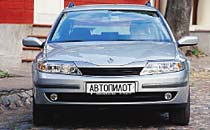 MINUS ONE. Laguna is much simpler. She does not have bargain, rather - sets up in a working way. But it is impossible to blame its creators of boring creation. Vice versa. Excessive avant -garde in solving some technical issues causes a conservative driver, to put it mildly, bewilderment.
MINUS ONE. Laguna is much simpler. She does not have bargain, rather - sets up in a working way. But it is impossible to blame its creators of boring creation. Vice versa. Excessive avant -garde in solving some technical issues causes a conservative driver, to put it mildly, bewilderment. There is no ignition key in our usual form. Its role is played by a plastic card, which with the gluttony of the ATM swallows the gap on the front console. The launch and stop of the engine are pressed on the Start/Stop button. A huge curtain on a microlyphone closes the radio - it rises easily, but in order to lower it, some muscular effort must be attached. Such that attention is distracted for at least 10 seconds. Correctly on the roads.
Otherwise, the second generation Renault Laguna retained the ascetic features of its predecessor. Moreover, we did not seek to ride the most sophisticated version. The experience of sales of this car in the territory of the once allied Latvia indicates that a station wagon with a new 2.0 liter engine and a mechanical checkpoint is in the greatest demand - a real workhorse. Of the additional bells and whistles, most buyers have a neighboring xenon and parking sensors. But the Riga price is attractive - $ 19 thousand. By the way, sales of the second generation Renault Laguna will begin in Russia no earlier than the spring of 2002, and the fate of the new gasoline engine with direct fuel injection is still foggy - most likely modifications with this complex and sensitive engine yet will be delivered to our country.
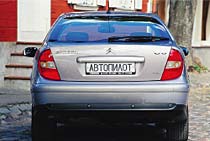 The accuracy of the course. The biggest surprise in C5 is handling. Because the first sensations - well, is very pleasant. The engine in the cabin is not heard. Starting from a place - spectacular enough for everyone else to enjoy the grace of the lines of your trunk. But then - continuous disappointment.
The accuracy of the course. The biggest surprise in C5 is handling. Because the first sensations - well, is very pleasant. The engine in the cabin is not heard. Starting from a place - spectacular enough for everyone else to enjoy the grace of the lines of your trunk. But then - continuous disappointment. At low speed, the steering wheel on C5 is absolutely cotton. It seems that the whole system lives its own life, different from the car and its driver. Citroen practically does not respond to small ruins of the steering wheel, the feeling that the engineers provided backlash as an element of configuration.
On our car, a hydraulic booster was installed with variable performance taking into account the speed of the car. So, at a speed already 100 km/h the steering wheel has become so heavy that it was just right to use it as a simulator for pumping muscles. It is doubly insulting, as it holds the direct road Citroen is simply amazing. Regardless of how the suspension is currently configured - for sports mode or on a simple ride.
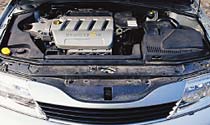 MOSCOW TIME. Ranault Laguna behavior is much simpler and more understandable. The engine of 2.0 liters of stars from the sky is not enough, but no one requires it. The motor has sufficient elasticity and burden, so that the driver with a trunk beaten to capacity (after all, the station wagon) does not feel humiliated and offended in the general flow of pizons on sedans and hatchbacks.
MOSCOW TIME. Ranault Laguna behavior is much simpler and more understandable. The engine of 2.0 liters of stars from the sky is not enough, but no one requires it. The motor has sufficient elasticity and burden, so that the driver with a trunk beaten to capacity (after all, the station wagon) does not feel humiliated and offended in the general flow of pizons on sedans and hatchbacks. To manage the new Laguna - how to tell the truth: easy and pleasant. The programs are turned on clearly, and they are selected competently. First-second-accelerated, on the third you can circle all day along the narrow streets of Riga.
Sitting is very convenient. The abundance of adjustments of the chair and the steering column allows you to get equally well when a painful driving along city traffic jams and relaxed - during long distances along the highway. In the latter case, after an hour or two, a noisy engine is slightly annoyed, but there is an antidote from this-a good standard radio with a CD player.
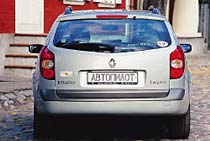 The overall impression was greatly spoiled by one annoying trifle - a liquid crystal display in the central part of the torpedo. It displays the usual information for machines of this class: radio waves, fuel temperature, fuel consumption, etc. But the numbers, as we found out, are suitable for reading only in cloudy weather - under the oblique rays of the sun, the display is completely blind.
The overall impression was greatly spoiled by one annoying trifle - a liquid crystal display in the central part of the torpedo. It displays the usual information for machines of this class: radio waves, fuel temperature, fuel consumption, etc. But the numbers, as we found out, are suitable for reading only in cloudy weather - under the oblique rays of the sun, the display is completely blind. Despite these or other annoying little things, we liked both cars. First of all, a design that is not characteristic of both firms in the past. Plus the original and relevant ergonomics of the salon corresponding to the purpose of the machines. But whether they will survive a craving for the culture of France once popular in Russia, not time will tell, but a more mundane characteristic - their price.
Text Nikolay Kachurin, photo Igor Timofeev
Cars are provided for the test by Musa Motors Riga (Renault Laguna II Break), (371) 706-6142, and Auto Statuss (Citroen C5), (371) 780-0133
On C5 it is installed by the hydropneumatic suspension Hydractive 3. By clicking on the key, you can choose one of the pre -installed positions of the body: normal, reduced, increased (to overcome off -road at speeds of up to 40 km/h), high (the car is lifted above the road by 40 mm and in this position and in this position It can also go, but not faster than 10 km/h).
At a speed of more than 110 km/h, electronics come into the business, and C5 squats at 15 mm in front and 11 mm behind. It is enough to reset speed up to 90 km/h so that the suspension will return to normal. When driving on pardins, the car body automatically rises by 13 mm. But for electronic sensors to cope with the analysis of the road surface, you cannot exceed the speed of 70 km/h
Model/Modification Citroen C5 Renault Laguna II Break
The manufacturer/country Automobiles Citroen/France Regie National Es Usines Renault/France
BODY
Type sedan universal
Number of doors/places 4/5 5/5
ENGINE
Basin type with electronic injection
Front location, transversely
Working volume (cubic meter) 2946 1998
The number/location of the cylinders 6/V-shaped 4/row
Power, kW (L.S.) at about./Min. 152 (207) at 6000 103 (140) at 5500
Moment (nm at about./Min.) 285 at 3750 200 at 4250
TRANSMISSION
Front drive
Automatic gearbox, 4-speed mechanical, 5-speed
SUSPENSION
Anterior hydropneumatics with a variable road clearance, independent, spring,
triangular transverse levers, stabilizer of the anti -resistance stability
The rear hydropneumatic with a variable road clearance, longitudinal levers, a rear bridge with a suspension of wheels on the connected longitudinal levers,
the reptile stabilizer
STEERING
Type gear rack with a hydraulic booster
Min. The diameter of the turn (m) 11.8 12.0
Brakes
Front disk, ventilated
The rear disc
Dimensions/volumes/weight
Length/width/height (mm) 4620/1770/1480 4700/1750/1440
Wheel base (mm) 2750 2745
Equipped mass (kg) 1480 1335
Tires/Disks 215/55 R16/6.5J 205/55 R16/6.5J
Dynamic characteristics
Maximum speed (km/h) 240 210
Acceleration to 100 km/h (sec.) 9.8 no data
Economy
Fuel consumption (l/100 km, city/highway) 14.5/7.6 10.5/6.0
The price in Moscow is $ 34.6 thousand $ 19 thousand (without customs)
A source: "Autopilot"
Video Crash tests Renault Laguna 2001 - 2005
Test drive by Renault Laguna 2001 - 2005
Renault Laguna 2001 Krash Test - 2005
Krassh Test: Detailed Information34%
Driver and passengers
12%
Pedestrians







